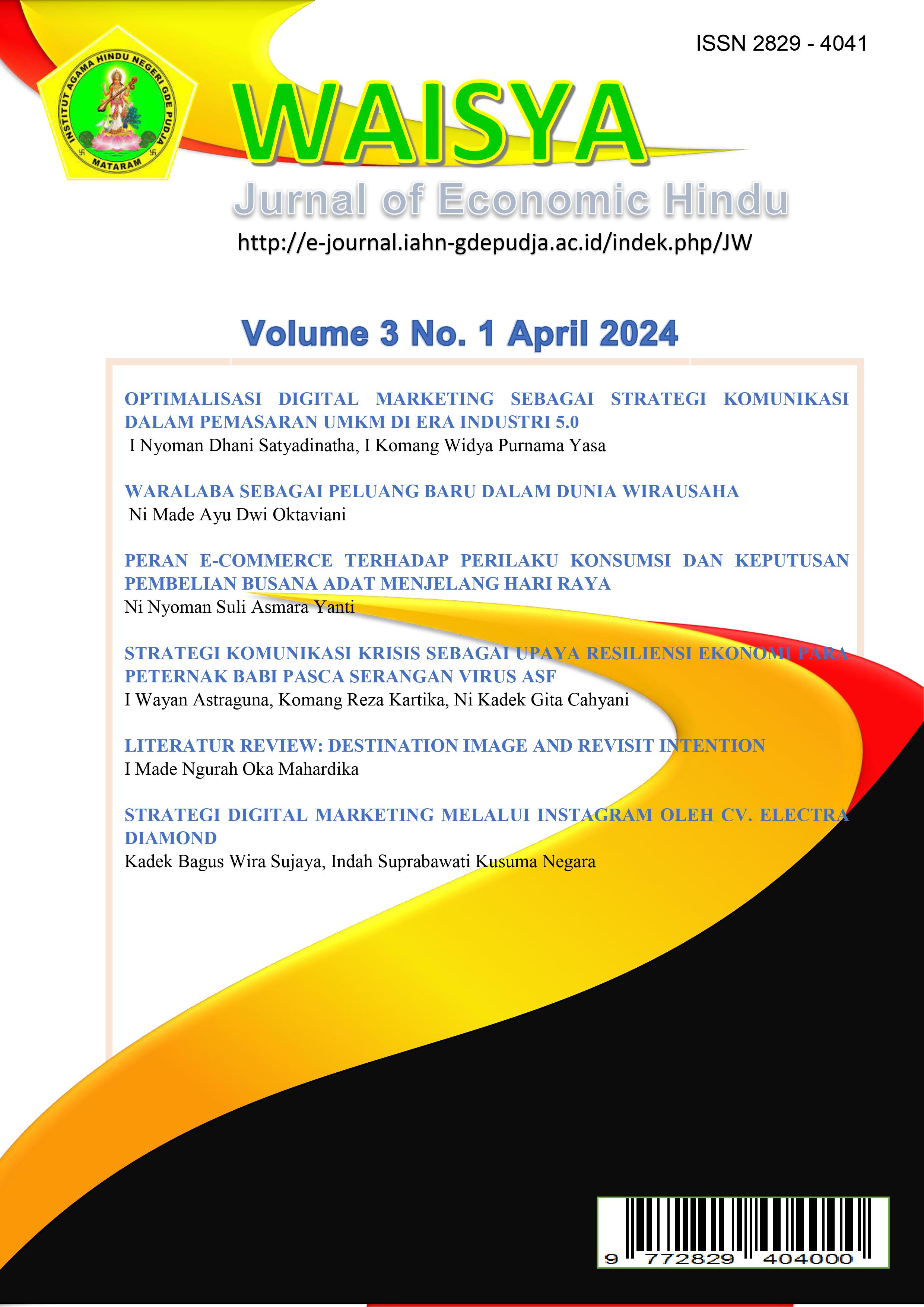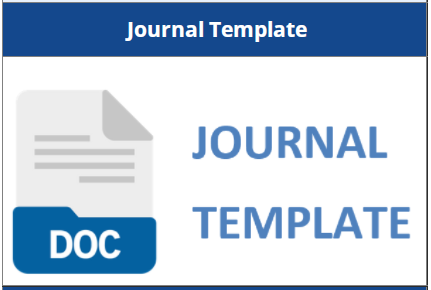LITERATUR REVIEW: DESTINATION IMAGE AND REVISIT INTENTION
Abstract
In the rapidly growing tourism industry, destination image plays a key role in influencing tourists' intention to revisit a place. This article outlines the relationship between destination image, experience, satisfaction, and intention to revisit. A positive destination image can shape tourists' satisfying experiences, which in turn increases their level of satisfaction and encourages the intention to return. Positive experiences during previous visits strengthen the desire to revisit the destination. Tourist satisfaction becomes a key factor in forming the intention to revisit, as it reflects the fulfillment of their expectations regarding the services and facilities provided. The article also outlines strategies that destination managers can take to enhance tourists' experiences and satisfaction, including improving service quality, interaction with local residents, and sustainable innovation. By understanding this relationship, destination managers can build a good reputation and create unique experiences for tourists, driving the growth and sustainability of the tourism industry.
References
Afriesta, C. L. B., Kuniawan, H. E., & Ekasiwi, S. N. N. (2020). Korelasi Antara Push dan Pull Factor Wisata Kawasan dan Bangunan Bersejarah. Jurnal Pariwisata Terapan, 4(1), 1. https://doi.org/10.22146/jpt.46036
Ajzen, I. (1991). The Theory Of Planned Behavior. Organizational Behavior And Human Decision Processes, 50(1), 179–211. https://doi.org/10.47985/dcidj.475
Anholt, S. (2008). Place branding: Is it marketing, or isn’t it? Place Branding and Public Diplomacy, 4(1), 1–6. https://doi.org/10.1057/palgrave.pb.6000088
Ariyanto, Z. M., & Prihandono, D. (2018). The Influence of Electronic Word-of-Mouth and Destination Image on Visit Decision Through Visit Intention As Intervening Variable. Management Analysis Journal, 7(3), 318–327. Retrieved from http://maj.unnes.ac.id
Atmari, N. V., & Putri, V. W. (2021). The Effect of Tourism Experience on Revisit Intention through Destination Image and Satisfaction. Management Analysis Journal, 10(1), 85–94. https://doi.org/10.15294/maj.v10i1.45503
Baker, D. A., & Crompton, J. L. (2000). Quality, satisfaction and behavioral intentions. Annals of Tourism Research, 27(3), 785–804. https://doi.org/10.1016/S0160-7383(99)00108-5
Baloglu, S., & McCleary, K. W. (1999). A Model Of Destination Image Formation. Annals of Tourism Research, 26(4), 868–897.
Beerli, Asunción, & Martín, J. D. (2004). Tourists’ characteristics and the perceived image of tourist destinations: A quantitative analysis - A case study of Lanzarote, Spain. Tourism Management, 25(5), 623–636. https://doi.org/10.1016/j.tourman.2003.06.004
Beerli, Asunciòn, & Martín, J. D. (2004). Factors influencing destination image. Annals of Tourism Research, 31(3), 657–681. https://doi.org/10.1016/j.annals.2004.01.010
Bianchi, C., Milberg, S., & Cúneo, A. (2017). Understanding travelers’ intentions to visit a short versus long-haul emerging vacation destination: The case of Chile. Tourism Management, 59, 312–324. https://doi.org/10.1016/j.tourman.2016.08.013
Bigné, J. E., Sánchez, M. I., & Sánchez, J. (2001). Tourism image, evaluation variables and after purhase behaviour: Inter-relationship. Tourism Management, 22(6), 607–616. https://doi.org/10.1016/S0261-5177(01)00035-8
Briner, R. B., & Denyer, D. (2012). Systematic Review and Evidence Synthesis as a Practice and Scholarship Tool. The Oxford Handbook of Evidence-Based Management, (November 2015). https://doi.org/10.1093/oxfordhb/9780199763986.013.0007
Carlos Castro, J., Quisimalin, M., de Pablos, C., Gancino, V., & Jerez, J. (2017). Tourism Marketing: Measuring Tourist Satisfaction. Journal of Service Science and Management, 10(03), 280–308. https://doi.org/10.4236/jssm.2017.103023
Chan, C. S., & Marafa, L. M. (2018). Branding places and tourist destinations: A conceptualisation and review. The Branding of Tourist Destinations: Theoretical and Empirical Insights, 15–42. https://doi.org/10.1108/978-1-78769-373-920181002
Chaudhary, M. (2000). India’s image as a tourist destination - a perspective of foreign tourists. Tourism Management, 21(3), 293–297. https://doi.org/10.1016/S0261-5177(99)00053-9
Chen, C. F., & Tsai, D. C. (2007). How destination image and evaluative factors affect behavioral intentions? Tourism Management, 28(4), 1115–1122. https://doi.org/10.1016/j.tourman.2006.07.007
Chen, J. V., Htaik, S., Hiele, T. M. B., & Chen, C. (2017). Investigating International Tourists’ Intention to Revisit Myanmar Based on Need Gratification, Flow Experience and Perceived Risk. Journal of Quality Assurance in Hospitality and Tourism, 18(1), 25–44. https://doi.org/10.1080/1528008X.2015.1133367
Chen, Y., Zhang, H., & Qiu, L. (2013). Liss 2012. Liss 2012, 593–604. https://doi.org/10.1007/978-3-642-32054-5
Chi, C. G. Q., & Qu, H. (2008). Examining the structural relationships of destination image, tourist satisfaction and destination loyalty: An integrated approach. Tourism Management, 29(4), 624–636. https://doi.org/10.1016/j.tourman.2007.06.007
Civelek, A. (2015). the Role of Branding in Destination Marketing. IJBTS International Journal of Business Tourism and Applied Sciences, 3(1), 65–69.
Dieguez, T., & Conceição, O. (2021). Experiential Tourism and Experiential Marketing: An Innovative Approach. Smart Innovation, Systems and Technologies, 209, 550–559. https://doi.org/10.1007/978-981-33-4260-6_47
Ebrahimi, P., Hajmohammadi, A., & Khajeheian, D. (2020). Place branding and moderating role of social media. Current Issues in Tourism, 23(14), 1723–1731. https://doi.org/10.1080/13683500.2019.1658725
Echtner, C., & Ritchie, J. R. B. (1993). An Empirical Assessment Image : An Empirical Assessment. Journal of Travel Research, 3–13.
Herle, F.-A. (2018). The Impact of Destination Image on Tourists’ Satisfaction and Loyalty in the Context of Domestic Tourism. Marketing – from Information to Decision Journal, 1(2), 14–26. https://doi.org/10.2478/midj-2018-0007
Isaac, R. K., & Eid, T. A. (2019). Tourists’ destination image: an exploratory study of alternative tourism in Palestine. Current Issues in Tourism, 22(12), 1499–1522. https://doi.org/10.1080/13683500.2018.1534806
Jeaheng, Y., & Han, H. (2020). Journal of Hospitality and Tourism Management Thai street food in the fast growing global food tourism industry : Preference and behaviors of food tourists. Journal of Hospitality and Tourism Management, 45(November), 641–655. https://doi.org/10.1016/j.jhtm.2020.11.001
Kerr, G. (2006). From Destination Brand to Location Brand. Brand Management, 13(4), 276–283.
Kieti, D. M., & Akama, J. S. (2003). Measuring tourist satisfaction with Kenya’s wildlife safari: a case study of Tsavo West National Park. Tourism Management, 24(1), 73. Retrieved from http://search.ebscohost.com/login.aspx?direct=true&db=hjh&AN=8667494&site=ehost-live
Kim, K., Hallab, Z., & Kim, J. N. (2012). The Moderating Effect of Travel Experience in a Destination on the Relationship Between the Destination Image and the Intention to Revisit. Journal of Hospitality Marketing and Management, 21(5), 486–505. https://doi.org/10.1080/19368623.2012.626745
Mohamad, M., Ali, A. M., Izzati, N., & Ghani, A. (2011). a Structural Model of Destination Image, Tourists’ Satisfaction and Destination Loyalty. International Journal of Business and Management Studies, 3(2), 1309–8047.
Nguyen Viet, B., Dang, H. P., & Nguyen, H. H. (2020). Revisit intention and satisfaction: The role of destination image, perceived risk, and cultural contact. Cogent Business and Management, 7(1). https://doi.org/10.1080/23311975.2020.1796249
Önder, E., Yıldırım, B. F., & Özdemir, M. (2013). Multi Criteria Decision Making Approach for Evaluating Tourism Destinations in Turkey. Akademik Turizm ve Yönetim Araştırmaları Dergisi, 1(1), 1–15.
Ragb, H., Mahrous, A. A., & Ghoneim, A. (2020). A proposed measurement scale for mixed-images destinations and its interrelationships with destination loyalty and travel experience. Tourism Management Perspectives, 35(March), 100677. https://doi.org/10.1016/j.tmp.2020.100677
Rinuastuti, B. H. (2016). Faktor Pembentuk Harapan Wisatawan; Sebuah Perspektif Lintas Budaya (Studi Pada Wisatawan Perancis, Australia, Dan Nusantara Yang Berkunjung Di Pulau Lombok). Jmm Unram - Master of Management Journal, 16(1). https://doi.org/10.29303/jmm.v16i1.13
Satriawan, A., Abdillah, Y., & Pangestuti, E. (2022). Analisis Destination Image Terhadap Revisit Intention Melalui Satisfaction Dan Place Attachment: Literature Review. Profit: Jurnal Administrasi Bisnis, 16(1), 146–157. Retrieved from https://profit.ub.ac.id/index.php/profit/article/view/1024
Schmitt, B. (1999). Experintial Marketing. Journal of Marketing Management, 15(January 2013), 37–41.
Sitepu, E. S., & Rismawati, R. (2021). The Influence of Service Quality, Destination Image, and Memorable Experience on Revisit Intention with Intervening Variables of Tourist Satisfaction. International Journal of Applied Sciences in Tourism and Events, 5(1), 77–87. https://doi.org/10.31940/ijaste.v5i1.2097
Stylos, N., Bellou, V., Andronikidis, A., & Vassiliadis, C. A. (2017). Linking the dots among destination images, place attachment, and revisit intentions: A study among British and Russian tourists. Tourism Management, 60, 15–29. https://doi.org/10.1016/j.tourman.2016.11.006
Sudiarta, I. N. (2012). Membangun Citra (Destinasi) Pariwisata Seberapa Pentingkah? Jurnal Ekonomi Dan Pariwisata, 7(1), 60–75.
Taan, H., Radji, D. L., Rasjid, H., & Indriyani. (2021). Social Media Marketing Untuk Meningkatkan Brand Image. Journal of Management & Business, 4(1), 315–330. https://doi.org/10.37531/sejaman.v4i1.1268
Wang, C., Zhu, Y., & Laksito, G. S. (2022). Factor Influencing Intention Repeat Tourism to Visit Singapore in New Normal based on Indonesia Traveler’s. International Journal of Business, Economics, and Social Development, 3(2), 53–63. https://doi.org/10.46336/ijbesd.v3i2.285
Yogiswari, N. M. M., Suryawardani, I. G. A. O., & Wiranatha, A. S. (2021). The Influence Of Experiental Marketing On Visitor Satisfaction and Intention To Revisit At Batur Camp Bali. Journal of Businesson Hospitality and Tourism, 07(01), 180–195. Retrieved from https://dx.doi.org/10.22334/jbhost.v7i1











